Explore Sultan Hassan Mosque – Cairo’s Iconic Mosque
The Sultan Hassan mosque is one of the most historical Islamic landmarks and a sample of the Mamluk architecture which is located in the centre of Cairo. This great mosque and madrasa constructed during the 14th century can only leave one impressed with the immense size, the neat stone work, and the aura of spirituality it creates. As a history lover or a curious visitor, Sultan Hassan Mosque integrates a fascinating insight into Egyptian culture and religious history. Learn why it is one of those Cairo sites you must visit.
- Overview of Sultan Hassan Mosque
- History of Sultan Hassan Mosque
- Architecture of Sultan Hassan Mosque Cairo
- Cultural and religious significance
- Activities in Sultan Hassan Mosque
- Best time to visit
- How to get there
- Things to know before visiting
- Places to visit near Sultan Hassan Mosque
- FAQs about Mosque of Sultan Hassan
- In conclusion
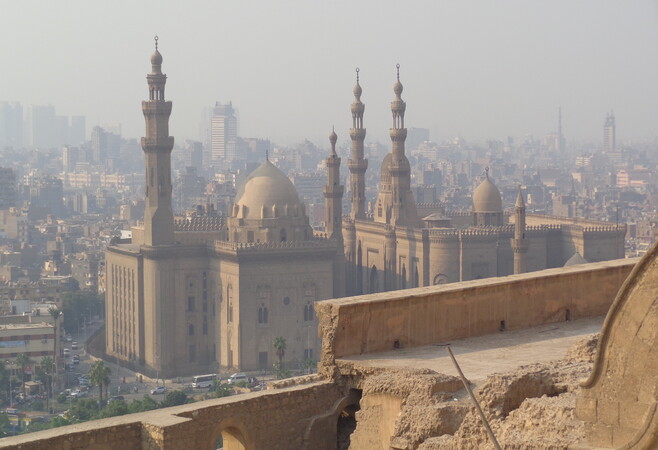
Dive into the story of Sultan Hassan Mosque
Overview of Sultan Hassan Mosque
The Sultan Hassan Mosque is a historic architectural gem in Cairo, renowned for its size, design, and cultural significance.
Location
The Sultan Hassan Mosque is situated in the historic region of Islamic Cairo and opposite to the Al-Rifai Mosque. It is located close to Salah Al-Din Square, at the base of Cairo Citadel, which is one of the most renowned Cairo features.
It is located in the center of Cairo in such a way that it is conveniently reachable by the people visiting the country's Islamic heritage of Cairo. Its location in relation to some major tourist sites also bolsters the attraction of the mosque, and it takes around 10–20 minutes by car to reach Tahrir Square from Sultan Hassan Mosque, depending on Cairo’s traffic.
Who built it
The Sultan Hassan Mosque was built under the guidance of Sultan an-Nasir Hassan who was a member of Bahri Mamluk dynasty. It started in 1356 AD and was finished in the year 1363 AD although he was assassinated in 1361 and before the mosque was completed.
It was during his tender years as a 13 year old that Sultan Hassan became sultan. His rule was characterized by political turmoil, and the long lasting legacy of his reign is the existence of this mosque. The mosque was to act as a worship house and a madrasa that taught all the four Sunni schools of Islam law.
Entrance fee and opening hours
Visitors to the Sultan Hassan Mosque can easily access the site throughout the week. Here are the key details for planning your visit:
- Opening hours: Daily from 9:00 AM to 5:00 PM
- Entrance fee:
- Foreign adults: 80 EGP
- Foreign students: 40 EGP
- Egyptian nationals: Lower rates apply
- Photography: Allowed, but professional equipment may require additional fees
- Dress code: Modest attire is required; women may be asked to cover their heads
The ticket often includes access to both Sultan Hassan and Al-Rifa’i Mosque, located directly opposite.
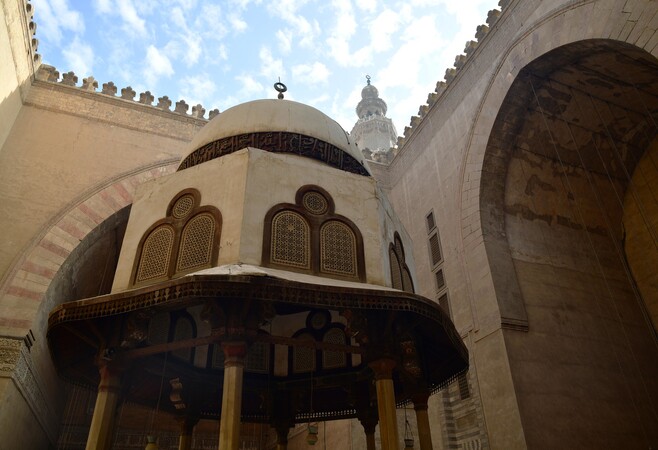
Opening hours and ticket information
If you're interested in discovering more stunning Islamic landmarks, don’t miss this guide to another beautiful mosque in Egypt that showcases the country’s rich architectural heritage.
History of Sultan Hassan Mosque
Sultan Hassan Mosque was ordered to be built in 1356 AD by Sultan an-Nasir Hassan who was a ruler of Bahri Mamluk dynasty. It took approximately seven years to be under construction and was almost finished by 1363 AD. Unfortunately, Sultan Hassan was assassinated in 1361 as the mosque was being finished and his body never got his deserved place in the mausoleum that was to be built in the mosque.
The mosque had a religious as well as educational purpose during its serene beginning. It operated as a madrasa, providing instructions in four most important schools of the Sunni Islamic law: Hanafi, Maliki, Shafi, and Hanbali. This enabled it not only to be a center of religion but also one of the most important religious institutes of learning in Cairo.
The building of the mosque is an architectural accomplishment of its ages demonstrating the affluence, power and aspiration of the Mamluk sultans. It emerged as an outstanding monument because of its monumental size, use of stone material and innovative additions to design.
A natural disaster and political upheavals that affected the mosque across a long period of hundreds of years have not dealt severe damage with the mosque as it is properly preserved nowadays and is considered to be one of the most significant Islamic constructions in Egypt. It is still interesting to historians, architects, and other travelers all over the world due to its historical and cultural background.
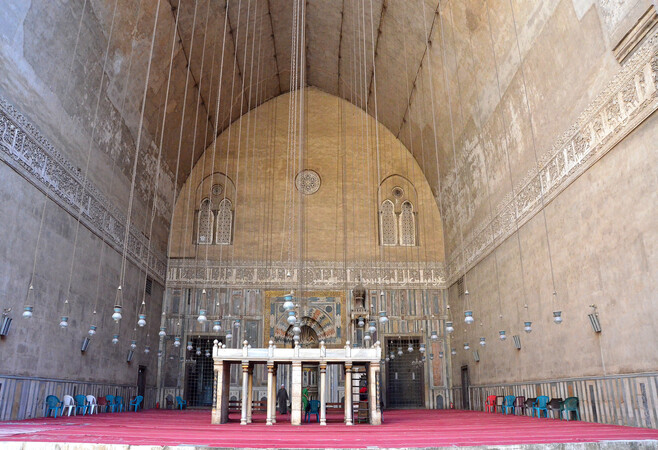
A glimpse into Sultan Hassan mosque’s past
For those interested in Cairo’s religious and educational legacy, the historic Al Azhar mosque Cairo Egypt offers a remarkable glimpse into the heart of Islamic scholarship.
Architecture of Sultan Hassan Mosque Cairo
The Sultan Hassan Mosque is regarded as one of the most excellent pieces of Mamluk architecture in Cairo. It is an Islamic design masterpiece of grand proportions and decor. They constructed the mosque out of limestone blocks, some of which were probably reused out of old Egyptian buildings which makes this mosque very sturdy and majestic in its aspect.
The mosque contains a cruciform plan and an open courtyard that is surrounded by four monumental iwans and as such represents the four schools of the Sunni schools of Islamic law. In the center of the courtyard is a domed ablution fountain which is typical in Islamic mosques that help to wash ritualistic cleansing.
Among the most notable features of the mosque, there is the entrance portal that reaches around 26 meters in height and comes into a vestibule with a fantastic dome. The minarets including the tallest one (reaching about 68 meters) were regarded to be one of the highest in the Islamic world during that time.
The interior decoration of the mosque embraces elaborate marble paneling, carved stucco and Kufic calligraphy. The fine marble and woodwork decoration of the mihrab (prayer niche) and minbar (pulpit) are the manifestations of great craftsmanship of the Mamluk times.
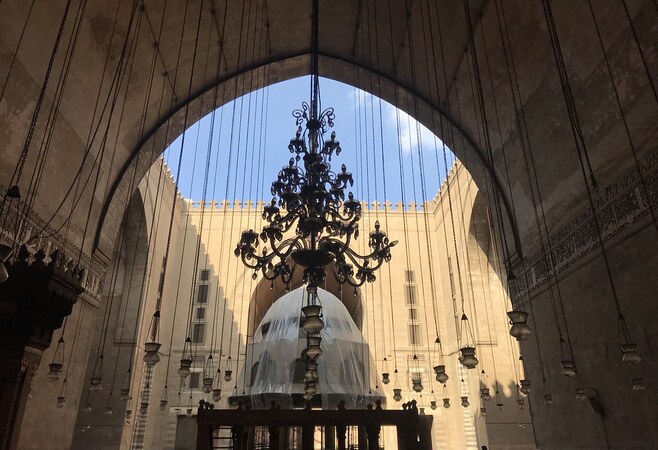
Structural beauty of Cairo’s Sultan Hassan mosque
Another revered site in Cairo worth visiting is the Al Hussein mosque Egypt, known for its deep spiritual significance and connection to the Prophet’s family.
Cultural and religious significance
The Sultan Hassan Mosque has its extensively superior cultural and structural significance to the entire city of Cairo and the Islamic world. Constructed in the Mamluk period, it was more than a mosque as it was a madrasa and so it acted as a center to learn the religion. It was also intended to educate all the 4 Sunni schools of Islamic law; the Hanafi, Maliki, Shafi and Hanbali side by side, and this was a daring architectural and teaching accomplishment in that day.
The mosque served as an active center of worship where the location offered a ground to pray each day and have sermons that were offered once a week on Fridays as well as religious festivals. Its huge prayer hall, reverberating iwans and religious aura still attract worshippers and academicians. The construction marks the attempts of the Mamluk rulers to advance the Sunni Islam and to make Cairo the center of religious and intellectual life.
The mosque has a cultural dimension to it because it reflects the history of Islamic Cairo and demonstrates the artistic success of the 14th century. Its magnificence, construction work and history have made it a valued piece of history in the Egyptian building heritage.
To this day, the mosque continues to serve as a house of worship and represents the religious and cultural heritage of Cairo to the impact that it attracts both reverent pilgrims and foreigners touring the city for the works of Islamic history and architecture.
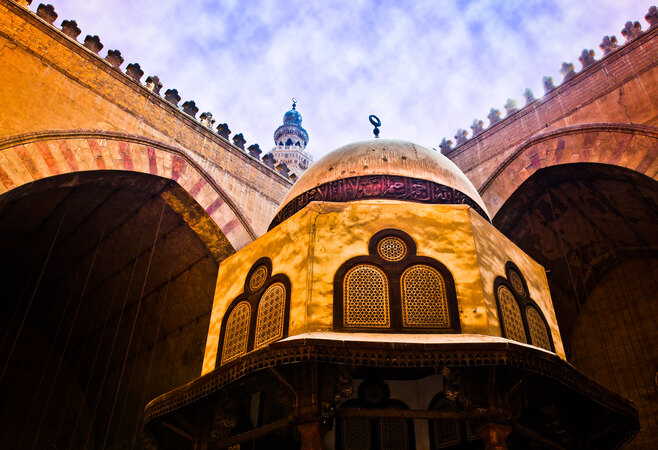
Spiritual and cultural value
To experience more of Cairo’s grand Islamic landmarks, be sure to visit the Muhammad Ali mosque in Cairo, famous for its Ottoman-style architecture and commanding presence within the Citadel.
Activities in Sultan Hassan Mosque
Visiting the Sultan Hassan Mosque offers a rich cultural and spiritual experience. Here are the top activities you can enjoy during your visit:
- Appreciate the architecture: Discover the monumental scale, the elegant nature of stone carvings and Mamluk structures of the mosque such as its elaborate stone-carved entrance, expansive iwans and intricately sculpted mihrab.
- Explore the Madrasa quarters: Tour the four iwans that once belonged to each of the four Sunni schools of Islamic jurisprudence. These were religious sites and contain a large historical importance through religious education.
- Watch prayers or praying: The mosque is an active prayer facility. Tourists can witness silent prayer or participate in prayer in the best way, observing the norms.
- Visit Mausoleum: view the tomb chamber that was intended to be used by Sultan Hassan. The area is significant to the mosque, even though he was never buried in the spot.
- Take pictures: Capture the beauty of the mosque’s interior and exterior. There are a lot of good photo opportunities on the light passing through the arches and domes.
- Take a guided tour: The local guide will bring you into the thick of the religious and historical background of the invention and usage of the mosque.
- Delight in the quiet environment: Spend some time and contemplate at the quiet courtyard and enjoy soaking up the spiritual aura possessed by this centuries old monument.
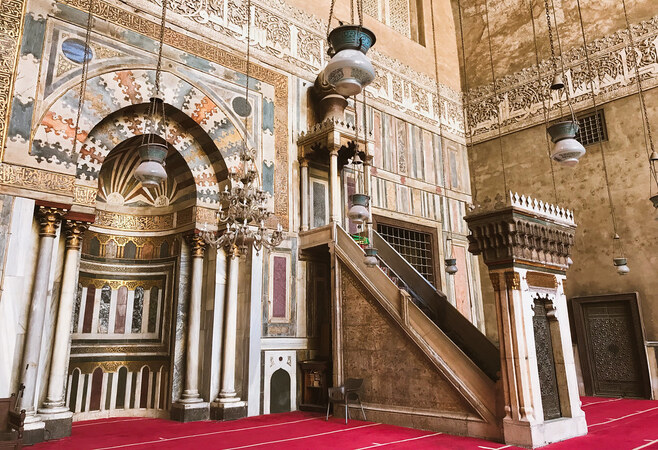
Visitor experiences at Sultan Hassan Mosque
Best time to visit
To make the most of your visit to the Sultan Hassan Mosque, consider the following timing tips:
- Early morning (9:00 AM – 11:00 AM): Fewer crowds and softer natural lighting make this an ideal time for photography and peaceful exploration.
- Weekdays (Sunday to Thursday): Avoid Fridays, the main prayer day, when the mosque may be busier with worshippers.
- Cooler months (October to April): Cairo's weather is more pleasant during these months, making sightseeing more comfortable.
- Non-holiday periods: Visiting outside of major Islamic holidays ensures a quieter and more relaxed experience.
How to get there
Reaching the Sultan Hassan Mosque in Cairo is convenient due to its central location near major landmarks. Here are your main options:
- Taxi or ride-hailing apps: very convenient by taxi or ride-sharing and hailing apps such as Uber and Careem. The journey to Tahrir Square is approximately 20-30 minutes depending on the traffic.
- Using public transport: Use the Cairo Metro to reach Sayeda Zeinab or El-Malek El-Saleh stations, then take a short taxi ride to the mosque.
- With a tour bus: Framed by many guided tours into the itinerary of the Islamic Cairo mosque, the combination of benefits of convenience and authentic background knowledge is accessible to all visitors.
- On foot (via citadel): It can be reached by foot, however, you will have to be already in the surrounding historic area since it lies adjacent to the Cairo Citadel.
Things to know before visiting
Before visiting the Sultan Hassan Mosque, keep the following tips in mind to ensure a respectful and enjoyable experience:
- Dress modestly: Wear long sleeves and pants or skirts; women may be asked to cover their heads.
- Respect prayer times: Non-Muslim visitors may have limited access during Friday prayers or special religious events.
- Entry fee applies: Bring cash (Egyptian pounds) for entry; fees vary for locals and foreigners.
- Photography is allowed: Personal photos are permitted, but professional equipment may need prior approval.
- Hire a guide: A local guide can enrich your understanding of the mosque’s history and architecture.
Places to visit near Sultan Hassan Mosque
The Sultan Hassan Mosque is surrounded by several must-see attractions in Islamic Cairo. Here are top nearby sites to include in your visit:
- Al-Rifa’i Mosque: Located directly opposite, this mosque houses the tombs of Egyptian royalty and Iran’s last Shah.
- Cairo Citadel: A historic fortress offering panoramic views of the city and home to the Mosque of Muhammad Ali.
- Mosque of Ibn Tulun: One of Cairo’s oldest mosques, known for its massive spiral minaret and unique architectural style.
- Gayer-Anderson Museum: A preserved Ottoman-era house with antiques, Islamic art, and cinematic history.
For a glimpse into even earlier Islamic architecture, the Ibn Tulun mosque in Cairo stands as one of the oldest and most architecturally distinctive mosques in the city.
FAQs about Mosque of Sultan Hassan
Here are the most frequently asked questions about visiting the Sultan Hassan Mosque to help you plan your trip better.
Can non-Muslims enter the Sultan mosque?
Honestly, anyone who is a non-Muslim is welcome to visit the Sultan Hassan Mosque. The visitors need to dress decently and mind the prayer timing. Whereas some prayer sections can be restricted at services, the mosque is available to everyone willing to know its history and architecture.
Is photography allowed inside the mosque?
Yes, taking photographs is usually allowed in the Sultan Hassan Mosque. Its architecture is a beauty to capture and, therefore, it is advisable to be decent when taking photos: do not take shots of worshippers at a time they are in prayer and do not put the flash or tripod to use without the permission of the authorities. There are certain areas where certain restrictions are in force, therefore, it is better to consult on-site staff on arrival.
Are guided tours available?
Yes, guided tours are available at the Sultan Hassan Mosque. Different tour operators provide these tours and they normally cover other attractions like the Al-Rifa Mosque and the Mosque of Ibn Tulun among other things. It also offers guided tours of the mosque so that one gets a good overview of the history of the mosque, its architecture and culture besides improving the entire visit. They normally provide the service of flexible schedule, hotel pick up and drop off, and are led by the informative guides. Reservation is recommended particularly at peak tourist season.
In conclusion
Sultan Hassan Mosque is a striking evidence of Islamic architecture and a monument of Cairo's rich cultural and spiritual heritage. Whether you're drawn by its history, breathtaking design, or spiritual atmosphere, the Sultan Hassan Mosque stands as one of Egypt’s most remarkable landmarks.
You can visit this architectural wonder yourself, but do not forget to apply online for an Egypt e-Visa beforehand. The procedure only takes a short time via the official Egypt Immigration Service website. Prepare your passport, book your flight, and be ready to witness the eternal beauty of Sultan Hassan Mosque.
Related Articles
- Business Visa Egypt – Requirements, Fees & How to Apply
- Student Visa Egypt Guide: Requirements, Fees & Process
- 5 Year Multiple Entry Visa Egypt: Full Guide & Updates
- How much is a visa from Nigeria to Egypt? Full cost guide
- Egypt Visa Extension: How to Apply, Requirements & Guide
- Egypt Transit Visa Guide: Requirements, Process & Tips











